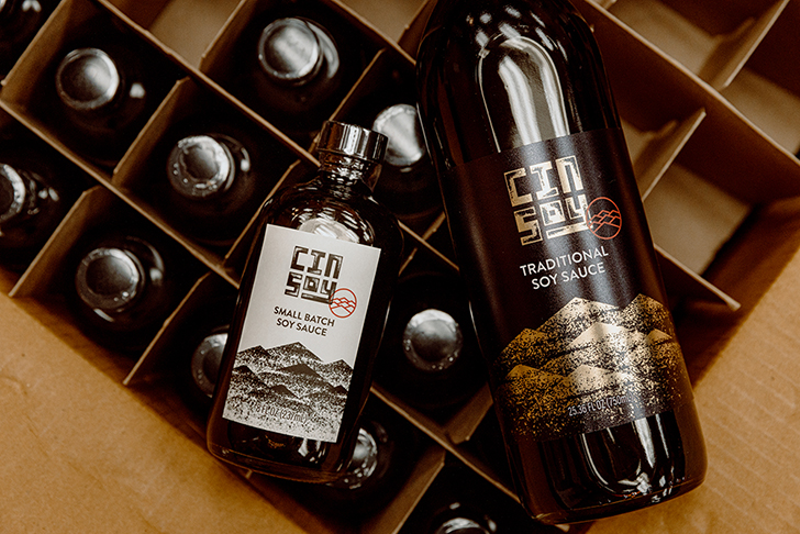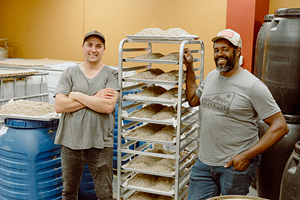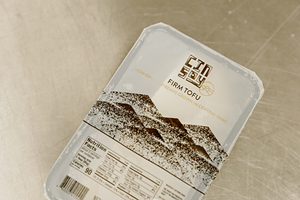Have you ever tasted local soy sauce? Until CinSoy launched in 2020, chances are high you’d never seen any on store shelves.
That’s why CinSoy’s small-batch soy sauce caught my eye while I was shopping at Morsel & Nosh deli in Northside. It’s a simple little glass bottle with a minimalist black-and-white screen print of seven hills — like Cincinnati’s — but the design evokes traditional Japanese woodblock prints. The bottle stood out because other types of local condiments are available all over town, but until now, soy sauce hadn’t been among them (based on my googling of “Ohio soy sauce”).
According to the United States Department of Agriculture’s 2020 Annual Bulletin, Ohio grows more soybeans than any other crop, with 4.87 million acres harvested in the state last year. Comparatively, corn, our state’s second-most prominent crop, saw only 3.55 million acres harvested.
There’s obviously a lot of soy around, although much of it is used as livestock feed and to replenish nitrogen levels in soil as a cover crop — not to make soy sauce.
CinSoy’s production facility is adjacent to the former Christian Moerlein Brewing Co. taproom in Over-the-Rhine, now occupied by the Cincinnati Beverage Company. On a recent visit, Sam Pellerito, CinSoy’s founder, welcomed me into the facility.
Warm air carried the fragrances of garlic, chili and caramel. “The Factory,” as Pellerito calls it, needs to stay warm; 78 degrees Fahrenheit is the ideal temperature to encourage healthy fermentation, which is the main process used in creating soy sauce.
“We’re on the Brewing Heritage Trail,” Pellerito says, referring to Over-the-Rhine’s series of guided tours and a free walking trail that explores, preserves and celebrates the city’s storied past as a beer-producing capital. “I just think it’s hilarious (because making soy sauce is one) of the oldest brewing processes in the world. I mean, brewing soy sauce is thousands of years old.”
On one side of the main room, there are plastic vats as large as hot tubs. Inside are soupy, bubbling mounds of soybeans. The mash foams with the life of fermentation as Pellerito stirs a vat, and an intoxicating perfume breathes out. If he had told me it was beer, I would have believed him.
“A lot of the procedures that homebrewers end up doing is pretty much what we live every day,” says Kendall Holmes, the other half of CinSoy, who merged his previous endeavor, Cloud Food Labs, with the company earlier this year. “Brew. Sanitize. Transfer. All the stuff you do to homebrew, we’re doing on a much larger scale.”
The turnaround isn’t nearly as quick as beer, though. CinSoy’s sauce takes half a year to reach the depth of flavor Pellerito and Holmes aim for.
“Some soy sauces (age) for three years. In Japan you’ve got four companies that are 450 to 500 years old and they’re still using the same equipment. They still have the same (cedar aging) barrels that they were using when their great-great-great-grandparents were making soy sauce,” Pellerito says. “It has a yeast, and that yeast is so super specific to soy sauce and the way that it makes soy sauce taste; they don’t add it to soy sauce, it’s just there.”
Holmes draws another beer comparison, saying that the flavor-imbued yeast in soy sauce is like the presence of Brettanomyces, a wild yeast that gives Belgian farmhouse ales, among others, an irreplaceable funkiness. It’s an ingredient that’s not always on the guest list, but is usually a welcome addition to the party.
Pellerito says he has that same yeast and that CinSoy is building its own yeast colony.
“Our latest batch of soy sauce has a piece of the very first soy sauce I ever made,” he says. “That’s how it lives. That’s how it gets better. It gets better over time, really, because you’re adding that legacy of flavor.”
Pellerito earned a culinary degree from Johnson & Wales University in Providence, Rhode Island, and worked in esteemed kitchens in Australia and Wales. Later, he started making soy sauce in his basement as an experiment.
“As a small-batch producer, we’re still pretty consistent because we’re not changing a lot. We’re just using soybeans, koji (a starter substance made by combining a cultivated mold with rice and soybeans, which is vital to making soy sauce, sake and miso), wheat and salt water,” Pellerito says. “We’re not trying to recreate the wheel of soy sauce.”
CinSoy sources its beans from Covington, Ohio, a village about 90 minutes north of Cincinnati. The beans’ protein content is higher than average, which enables more flavor to be extracted during fermentation.
“When I go, there are trucks from Japan, trucks from China, trucks from Korea,” Pellerito says. “They’re all coming to get the soybeans because Ohio has the best soybeans in the world for making soy-based products.”
When it comes to soy-based products, sauce isn’t the only thing CinSoy offers. I also left The Factory with miso, tofu and a packet of soy sauce salt — a crystalized transformation of CinSoy’s small-batch sauce.
The company also produces koji mustard, a wildly delicious and unique invention from Holmes. For those who like it hot, there’s chili crisp oil. CinSoy also makes tamari, a cousin of soy sauce made from the liquid collected from the miso-making process — slightly thicker and less salty than conventional soy sauce, but capable of transforming dishes with its abundance of umami. For the DIYer, there’s even the “Make at Home Miso Kit,” which includes soybeans, CinSoy’s koji starter and everything needed to make your own batch of miso at home.
Learn more about CinSoy and find out where you can buy products locally at cinsoyfoods.com.








